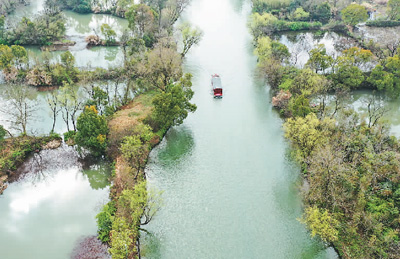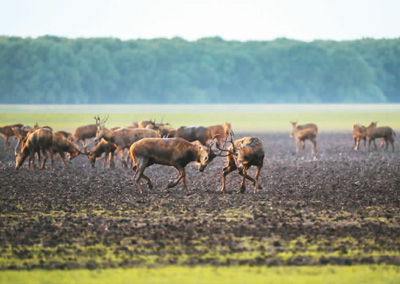Redoubled efforts crisscrossing China achieve successes in safeguarding wetlands of Yangtze River basin
The ecological environment of wetlands in the Yangtze River basin, which drains water from across a huge area of China, has been greatly improved, thanks to the country’s relentless efforts over the years.

Photo shows the Haoji Railway line and Hangrui Expressway running through the reed marshes of the East Dongting Lake National Nature Reserve in Yueyang city, central China's Hunan Province, a nature reserve located in the eastern section of Dongting Lake that was included among the first batch of national-level wetlands in China of international importance. (Photo/Zhao Min)
According to the National Forestry and Grassland Administration, the 11 provinces and municipalities that the river passes through implemented 39 ecological compensation programs, turned 514,000 mu (about 34,267 hectares) of marginal farmland into wetlands, and carried out a series of wetland conservation projects during the period from 2016 to 2020.
Rigorous efforts have been made at the source area of the country’s longest river. Tanggula township, Golmud city, in the Haixi Mongolian and Tibetan Autonomous Prefecture of northwest China's Qinghai Province, relocated 407 local residents in 128 households from the source area in 2004 to protect the rivers, lakes and wetlands there. Settling down in a new village, the relocated people who were once herdsmen are now engaged in ecological conservation efforts. To date, there are 597 grassland rangers and 101 wetland rangers working in the township.
Besides, the country has also adopted artificial precipitation enhancements to increase precipitation levels, constructed irrigation facilities, and increased vegetation coverage to protect water resources in the source area.

A boat sails on a river within the Xixi National Wetland Park in Hangzhou, capital of east China's Zhejiang Province in the early springtime. (Xinhua/Weng Xinyang)
Southwest China's Sichuan Province has restored the Ruoergai wetland on the Qinghai–Tibetan Plateau, the largest alpine peatlands in the world, which was once threatened by overgrazing and pollution. Ten years ago, the province launched a series of programs, such as wetlands restoration, surveys of ecological conditions, biodiversity protection, the prevention and control of pests, rodents and pollution. It established the Ruoergai National Wetland Park in 2016. The efforts proved effective, evidenced by a growing number of rare black-necked cranes, the only plateau crane species in the world, according to Xiong Yuanqing, a senior engineer of the bureau of forestry and grassland in Ruoergai county, Sichuan.
Junshan district, Yueyang city in central China's Hunan Province, once plagued by dusty weather caused by sand and gravel docks, banned 39 illegal docks on the riverbank of the Yangtze River and on the lakeside of Dongting Lake, China’s second-largest freshwater lake in the Yangtze River basin, as well as working to restore vegetation. Consequently, rare birds and Yangtze finless porpoises, known as the "giant panda of the water," were later spotted again in the area.
East China’s Anhui Province has launched 10 wetland restoration projects covering a total area of 100 square kilometers since 2018, and has already completed nine of them. All located around Chaohu Lake, China's fifth-largest freshwater lake, these projects stored 269 million cubic meters of floodwater during the floods in 2020, greatly reducing pressures from flooding in urban areas. Besides, the wetlands located near the lake are now home to 275 species of plants, which is up from 211 in 2013.

Photo shows a large herd of David’s deer (Elaphurus davidianus) frolicking about in the Shishou Milu National Nature Reserve in Jingzhou city, central China's Hubei Province. (Photo/Zhao Min)
East China’s Jiangxi Province restored over 75,000 mu of wetlands during the period from 2016 to 2020. It strictly controlled the exploitation of wetlands in addition to implementing a policy of balancing the occupation and replenishment of wetlands. Now millions of waterfowl, including over 95 percent of the world’s white cranes, winter in Poyang Lake, China's largest freshwater lake located in the province.
With 361 national-level wetland parks and 424 key provincial wetlands scattered across the Yangtze River basin, these protection efforts have also improved the living environments of local people as well as delivering economic benefits. For example, residents in Wuhan city, capital of central China's Hubei Province, can watch birds and cherry blossoms while also acquiring knowledge about wetlands in the Wuhan East Lake National Wetland Park. Tourists can sail on the rivers in the Xixi National Wetland Park in Hangzhou, capital of east China's Zhejiang Province, which was the first national wetland park in China and remains one of the Ramsar Wetlands of International Importance.
Yancheng city in east China’s Jiangsu Province is home to 770,000 hectares of coastal wetlands, where millions of birds stop over, breed, or winter every year. With 54 percent of the wetlands in the city under protection, the city has been able to develop a local wetland tourism industry. Tiaozini, part of the wetlands, is a great place for bird watching. Tourists can enjoy themselves in the Yellow Sea National Forest Park by riding bikes or watching cranes, deer and spoon-billed sandpipers.
Photos
Related Stories
- Feature: Wetland in Beijing welcomes "living fossil" Chinese merganser duck
- Protected wetlands in Ningxia sees increasing number, variety of migratory birds
- China's wetlands of int'l importance improving: white paper
- China sees continuous improvement in wetland ecology
- Scenery of wetland park in east China's Jiangxi
- National wetland park in Hubei a paradise for wild bird
- Scenery of Lixiang Lake National Wetland Park in Chongqing
- Growing number, variety of migratory birds reflect China’s continuous efforts in wetland protection
- Caofeidian wetland in north China's Hebei, habitat for migratory bird species
- In pics: swans at Hekou Reservoir wetland in Yulin, NW China
Copyright © 2022 People's Daily Online. All Rights Reserved.










